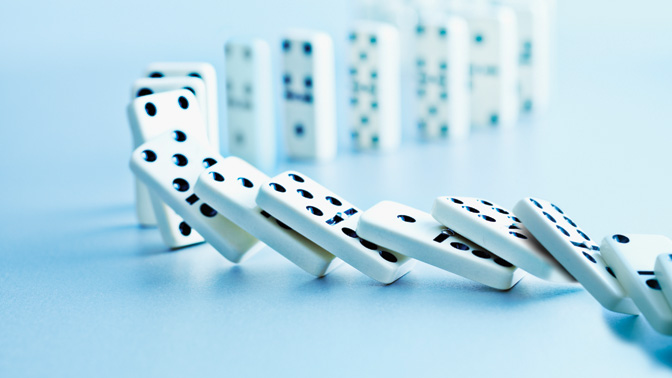Home page Description:
UHN scientists develop a conductive biomaterial that prevents abnormal heartbeats.
Posted On: April 20, 2018

Image Caption:
Electrical signals are conducted from one heart cell to another in a domino-like effect that makes the heart beat in rhythm.
A new material developed at the Toronto General Hospital Research Institute (TGHRI) by Dr. Ren-Ke Li has been found to repair irregular heartbeats in damaged heart tissue and could change the way heart attacks and heart failure are treated in the clinic.
Heart attacks and heart failure are major causes of disability and death in Canada. Following a heart attack, heart cells called cardiomyocytes die and scar tissue is formed to repair the gaps left behind by the dead cells.
The presence of the scar tissue creates a barrier between the cardiomyocytes, isolating them into physically separated islands, such that they are no longer able to communicate with each other.
Explains Dr. Ren-Ke Li, “Cardiomyocytes normally interact with each other through electrical signals that allow them to beat in a synchronized fashion. The formation of scar tissue disrupts and delays the conduction of this signal, leading to an irregular heartbeat known as a cardiac arrhythmia.”
While treatments for arrhythmias, including medication and pacemaker surgery, are widely available, a large proportion of patients do not respond to therapy. To address this, the laboratories of Dr. Li and his colleagues have been exploring new ways to repair abnormal heart conductivity.
As part of a recent study, they created a new injectable biomaterial composed of a conductive polymer and a naturally-occurring sugar. Dr. Li and his team found that the new biomaterial was able to synchronize the contraction of physically-separated cardiomyocytes in a petri-dish. Moreover, when injected into the heart scar tissue in an experimental model, the biomaterial reduces the delay in the conduction of electrical signals, which decreases the chance of arrhythmia.
“Our team is really excited about this new biomaterial and we have already planned preclinical experiments that will help advance this technology one step closer to use in humans” says Dr. Li.
“Because cardiac arrhythmia remains a major contributor to disability and death in Canada, the development of new and effective treatments could be transformative for the health and wellness of people with heart conditions.”
This work was supported by the Heart and Stroke Foundation of Ontario, a Heart & Stroke/Richard Lewar Centre of Excellence Studentship to Z. Cui and the Toronto General & Western Hospital Foundation. R-K Li holds a Tier 1 Canada Research Chair in Cardiac Regeneration and TM Yau holds the Angelo & Lorenza DeGasperis Chair in Cardiovascular Surgery Research.
Cui Z, Ni NC, Wu J, Du GQ, He S, Yau TM, Weisel RD, Sung HW, Li RK. Polypyrrole-chitosan conductive biomaterial synchronizes cardiomyocyte contraction and improves myocardial electrical impulse propagation. Theranostics, 2018; 8(10): 2752-2764. doi:10.7150/thno.22599.




